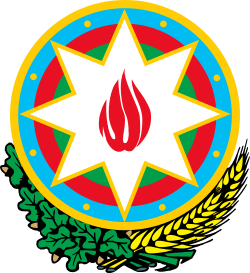Aghjabadi District
| Aghjabadi District Ağcabədi Rayon | |
|---|---|
| Rayon | |
.svg.png) Map of Azerbaijan showing Aghjabadi Rayon | |
| Country | Azerbaijan |
| Established | 8 August 1930 |
| Capital | Ağcabədi |
| Area | |
| • Total | 1,760 km2 (680 sq mi) |
| Population (2010) | |
| • Total | 122,649 |
| • Density | 70/km2 (180/sq mi) |
| Postal code | 0400 |
| Telephone code | (+994) 21[1] |
Aghjabadi (Azerbaijani: Ağcabədi) is a rayon in central Azerbaijan with an administrative center in the town of Aghjabadi.
History of the rayon
Aghjabadi rayon was established in 1930. In 1963 it was abolished and connected to Agdam Rayon. Soon after, in 1965, it was reestablished as an independent rayon. Aghjabadi is one of the ancient regions of Azerbaijan. In translation from Azerbaijani, it means "big settlement" ("aghja" – big, "badi" – residence, settlement). The ancient monuments discovered on the territory of Aghjabadi rayon attest to human habitation dating to the Eneolithic, Bronze Age periods. There are also remnants of the Middle Ages found at the Kamiltepe, Nargiztepe, Garakober, Yantepe, Galatepe and Gavur archeological sites.
Among the remains of the Eneolithic Age are the cemetery and the residence site called "Kichik" on the kurgan barrow in the village of Boyat, ruins of an ancient settlement Yastitepe in the village of Hindarx, residence sites Akhanglitepe, Keshaltitepe, Jafargulutepe, Husulutepe in Hacılar village, ruins of Kamiltepe and Shahtepe settlements in Yeni Qaradolaq village, the archeological sites of Sutepe, Agtepe and Janavartepe in Taynaq village, Mirvaritepe I and II, Abiltepe I and II, Muhammedtepe in the İmamqulubəyli municipality.
Archeological sites dating back to the Bronze Age include Kultepe, Saribashtepe, Uchtepe, Shahtepe in Agjabadi, Gyshaltitepe, Qebristanliqtepe, Galatepe in Boyat village, Elashantepe in Gələbədin, kurgan barrows Gushtepe, Huseinbey and Gazantepe in Hindarx village, and Sumuklu-tepe in Cəfərbəyli village.
Ancient living settlements have been discovered in Təzəkənd (5th-2nd millennia BC), Arazbar (1st millennium), Qiyaməddinli (1st millennium) and Hüsülü villages, as well as the Sangartepe and Toratepe living settlements found in Sarıcalı and Şənlik villages.
Several historical monuments, one school, the Regional Centre of Culture and a library were destroyed and burned by Armenians during the Karabakh War in Yuxarı Qiyaməddinli village.[2]
Geography and economy
Rayon is located 374 km from the capital Baku and 45 km from the closest town of Agdam. The relief in Aghjabadi is plain. The soil is rich with clay. The climate is mild subtropical, warm and dry. Average monthly temperature in January is 1.2–1.7 °C and in August is 25–30 °C. Kura River flows on the north-eastern border of Aghjabadi rayon and Qarqar River flows through its central part. Upper Karabakh channel also crosses the district. There are many salty lakes on the territory of Aghjabadi rayon, grey and gray soil is prevalent although halophytic type of soil is also widespread.
Demographics
There are 46 settlements and 1 town in the district. There is an airport and a railway station in the administrative center city of Ağcabədi.[2] The population of Aghjabadi rayon is 122,649 (according to 2010 census). Out of them 46,919 live in the city and 75,730 live in the country. The trend (82,700 lived in the country in 2008) shows that there is rapid urbanization in the district.[3] Out of the whole population, 62,310 are males, 60,339 are females. There is an increase in the birth rate too. In 2000, there were 1,659 newborns when in 2009 there were 2,377. Likewise, there were 491 new marriages in 2000 when there were 1,188 in 2009.[4] A large part of Kurds who had fled from Armenia and Nagorny Karabakh, eventually settled in the district.
Notable people
- Uzeyir Hajibeyov – composer
- Inqilab Nadirli – writer
- Afrasiyab Badalbeyli – composer and conductor
- Shamsi Badalbeyli – composer
- Tofik Bakhramov – football referee
- Zulfu Adigozalov – khananda
- Vasif Adigozalov – composer
- Isi Malikzadeh – writer
- Sabir Novruzov – mugam singer
References
- ↑ "Şəhərlərarası telefon kodları". Aztelekom MMC. Aztelekom İB. Retrieved 19 August 2015. (Azerbaijani)
- 1 2 Президентская библиотека Азербайджанской Республики. При содействии Академии Наук. Baku. 2008. p. 37.
- ↑ "Demoqrafik göstəricilər". Retrieved 26 January 2010.
- ↑ "Ağcabədi rayonu / Əhalinin sayı (1 yanvar 2010-cu il vəziyyətinə)". Retrieved 26 January 2010.
| Wikimedia Commons has media related to Aghjabadi Rayon. |
| Part of the series on |
| Azerbaijan Azərbaycan |
|---|
  |
| Culture |
| History |
| Demographics |
| Geography |
| Administrative divisions |
| Azerbaijan portal |
Coordinates: 40°3′10″N 47°27′41″E / 40.05278°N 47.46139°E